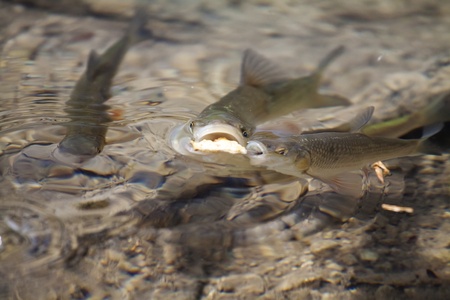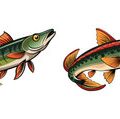1. Understanding Mackerel and Their Behaviour in British Waters
If you’re keen to master mackerel spinning along the UK coastline, your first step should be truly understanding your quarry. Mackerel are one of Britain’s most popular sea fish, known for their speed, aggression, and abundance during certain times of the year. These silver torpedoes travel in large shoals and can provide exhilarating sport on light tackle—but catching them consistently requires a bit of local knowledge and timing.
Seasonal Habits of Mackerel
Mackerel migrate to British waters in spring, usually arriving between April and May as sea temperatures begin to rise. They remain plentiful through the summer and early autumn before heading back to deeper offshore waters as winter approaches. The table below outlines their typical seasonal movements:
| Month | Mackerel Presence | Notes |
|---|---|---|
| April – May | Sporadic arrivals | First shoals appear, especially in southern regions |
| June – August | Peak season | Large shoals close to shore across the UK coastline |
| September – October | Declining numbers | Shoals disperse, good catches still possible in some areas |
| November – March | Mainly offshore/deep water | Difficult to target from shore or small boats |
Feeding Patterns and Preferred Prey
Mackerel are opportunistic feeders, preying on small fish such as sandeels, sprats, and juvenile herring. Their feeding frenzies often happen near the surface at dawn and dusk when baitfish are most active. Savvy anglers watch for tell-tale signs like diving seabirds or shimmering patches on the water—both indicators of mackerel hunting below.
Typical Locations Along the UK Coastline
The best spots for spinning are usually piers, breakwaters, harbour walls, and rocky headlands—anywhere that offers deep water close to shore. In these areas, tidal flow brings baitfish within reach, making them prime ambush zones for marauding mackerel. Here’s a quick overview:
| Location Type | Why It Works |
|---|---|
| Piers & Jetties | Deep water access; easy casting platform; attracts baitfish. |
| Rocky Headlands | Tidal currents concentrate food; natural shelter for prey species. |
| Sandy Beaches (Steeply Shelving) | Mackerel come close in on flooding tides chasing sandeels. |
| Harbour Entrances | Baitfish get funnelled by structure; regular tidal movement. |
Local Insight: Timing Is Everything
The most productive sessions often coincide with a rising tide at dawn or dusk—classic “mackerel o’clock” around British shores. By tuning into these patterns and learning how mackerel behave locally, you’ll build a strong foundation for spinning success throughout the season.
2. Essential Tackle and Gear for British Mackerel Spinning
If you’re serious about mackerel spinning in British waters, having the right kit is half the battle won. Over the years, I’ve learnt that a solid setup not only boosts your catch rate but also makes the whole experience far more enjoyable and efficient. Let’s break down what you really need for successful mackerel spinning around the UK coast.
Rods: Length, Action, and Local Favourites
For most British marks, a spinning rod between 8ft and 10ft hits the sweet spot—long enough to achieve good casting distance from piers or beaches, yet light enough for all-day action. A fast to medium-fast action rod helps flick lighter lures and gives you the sensitivity needed for those tell-tale bites.
| Rod Length | Action | Popular Brands |
|---|---|---|
| 8-9ft | Fast | Daiwa Ninja, Shakespeare Agility |
| 9-10ft | Medium-Fast | Sonik SKS Black, Penn Squadron II |
Reels: Size Matters
A 3000 to 4000 size fixed spool reel is ideal—compact, smooth and capable of holding enough line for those long casts. Look for robust gearing as saltwater can be unforgiving, and always rinse after use.
| Reel Size | Main Feature | Recommended Models |
|---|---|---|
| 3000 | Smooth Drag, Lightweight | Shimano Sienna FG, Daiwa Crossfire LT |
| 4000 | Larger Capacity, Durability | Penn Battle III, Okuma Ceymar C40 |
Lines: Balance Strength with Subtlety
Braided lines (12-20lb breaking strain) are a top choice for their casting distance and sensitivity. If you’re fishing in clear water or pressured spots, consider adding a short fluorocarbon leader (10-15lb) to reduce visibility. Always check local tackle shops—brands like Berkley FireLine and SpiderWire are reliable choices among UK anglers.
Lures: What Works Best Around Britain?
Mackerel respond brilliantly to shiny lures that mimic small baitfish. Sabiki rigs are a staple on many UK piers, but don’t overlook simple metal spinners (20-40g), feathers, or jelly eels when targeting bigger shoals. Here’s a quick comparison:
| Lure Type | Typical Weight/Size | Best Use Scenario |
|---|---|---|
| Metal Spinner (e.g., Dexter Wedge) | 28-40g | Casting from beaches/pier ends |
| Sandeel Imitation (e.g., Sidewinder) | 12-18cm / 25-35g | Ledges & rocky marks at dawn/dusk |
| Sabiki Feathers (e.g., Fladen) | N/A (rig) | Piers during summer runs of mackerel |
Tried-and-Tested Setup Advice from British Shores
A classic all-rounder setup would be a 9ft fast action rod paired with a 3000 size reel loaded with 15lb braid and a metre of 12lb fluorocarbon leader. Attach a 30g silver spinner or set up a string of feathers depending on conditions. Don’t forget corrosion-resistant terminal tackle—a common oversight that can cost you fish in salty environments.
A Final Word: Invest Wisely and Adapt Locally
The best gear is often what suits your local mark and style. Visit your nearest tackle shop—they know what’s working right now along your stretch of coast and can offer invaluable advice honed by real-world catches. Equip yourself smartly, maintain your gear religiously, and you’ll be ready for mackerel season wherever you cast around Britain.
![]()
3. Proven Spinning Techniques for UK Shores and Piers
Step-by-Step Guidance: Mastering the Basics
Spinning for mackerel around the British coastline is a blend of skill, timing, and adaptability. The unique conditions found on our shores — from choppy North Sea piers to calmer South Coast bays — demand specific techniques. Here’s a practical, step-by-step breakdown tailored for British anglers:
Step 1: Effective Casting
- Choose the Right Spot: Look for deep water close in, such as the end of a pier or rocky outcrop. Mackerel shoals often patrol these areas during incoming tides.
- Casting Motion: Use a smooth, overhead cast with your spinning rod (8-10ft preferred for distance). Avoid jerky movements to prevent tangles, especially in windy conditions common to UK shores.
- Distance & Accuracy: Aim beyond visible shoals or seabirds working baitfish. Don’t be afraid to experiment with angles if the wind shifts.
Step 2: Retrieving Techniques
- Vary Your Retrieve: Start with a fast, steady retrieve to mimic fleeing baitfish. If bites slow down, alternate with a stop-start or twitching motion to trigger strikes.
- Tide Awareness: On strong tides, let your lure sink longer and retrieve slower — mackerel often sit deeper during peak flow.
- Pier vs Shore: From piers, drop your lure straight down and jig vertically if you spot shoals below. From beaches or rocks, use longer casts and fan out your retrieves to cover more ground.
Step 3: Lure Presentation
- Lure Choice: In clear water and bright light, go for silver spinners or feathers. On murky days or at dusk, try chartreuse or pink patterns for extra visibility.
- Presentation Table:
| Lure Type | Best Condition | Retrieve Style |
|---|---|---|
| Silver Spoon/Spinner | Clear water, sunny days | Fast & steady |
| Mackerel Feathers/Sabiki | Turbid water, overcast | Bounce & pause |
| Soft Plastic Sandeel | Dusk/dawn, low light | Smooth lift & drop |
Real-World Tips: Adapting to British Weather and Tides
- Dress for the Elements: Waterproofs and layered clothing are a must; sudden showers and brisk winds are part of the experience on UK piers.
- Tidal Timing: Plan sessions around the last two hours of the flood tide — mackerel are most active as food is swept inshore.
- Adapt Your Gear: Use heavier lures (30-40g) during rough weather or strong tides to maintain control and reach feeding fish.
- Sneaky Tip from Old Hands: If crowds gather at one spot on the pier, quietly move 20 yards away — pressured fish often break off and feed where it’s quieter.
The Takeaway
The best mackerel spinning results come from reading local conditions and being flexible with your approach. With these time-tested techniques and a bit of trial-and-error honed by British weather, you’ll soon find yourself filling your bag while others scratch their heads nearby!
4. Top Mackerel Spots Across the UK
When it comes to spinning for mackerel, location is everything. Britain’s coastlines offer a diverse range of spots, from bustling piers to secluded rocky outcrops, each with its own charm and challenges. Based on years of practical experience and insider tips from local anglers, heres a curated guide to the top mackerel fishing destinations across England, Scotland, Wales, and Northern Ireland—complete with public access details and the ideal times to cast your line.
England: Iconic Piers and Hidden Corners
| Location | Region | Access | Best Time |
|---|---|---|---|
| Brighton Marina | Sussex | Public, all year round | June–September, dusk & dawn |
| Selsey Bill | West Sussex | Public foreshore | July–August, incoming tide |
| Plymouth Hoe | Devon | Pier access, parking nearby | May–September, early morning |
| Tynemouth Pier | North East | Permit required for extended pier sections | Late June–August, late afternoon |
| Cromer Pier (lesser-known) | Norfolk | Open to public, day ticket available | July–early September, high tide |
Scotland: Wild Waters and Local Favourites
| Location | Region | Access | Best Time |
|---|---|---|---|
| Anstruther Harbour | Fife Coast | Main harbour wall open to public | June–August, evening rising tide |
| Dunbar Harbour (renowned) | Lothian | Pier and breakwater accessible year-round | July–September, two hours before high tide |
| Mallaig Breakwater (lesser-known) | Highlands & Islands | Largely unrestricted public access | Mid-June–late August, calm evenings best |
| Kyleakin Pier (Isle of Skye) | Inner Hebrides | No permit needed; limited facilities available nearby | July–September, twilight hours |
| Buckie Harbour (local tip) | Buckie, Moray Firth | Main quay open to anglers | June–early September, early mornings |
Wales: Rugged Shores and Classic Hotspots
| Location | Region | Access & Facilities | Best Time |
|---|---|---|---|
| Llandudno Pier | Northern Wales | Pier fee applies; tackle shop onsite | July–September , dusk preferred |
| Penarth Pier | South Wales Coast | Public , parking close by | June – August , flood tide best |
| Aberystwyth Jetty (lesser-known) | Ceredigion Bay | Publicly accessible , ample space | July – early September , sunrise or sunset |
| Holyhead Breakwater (renowned) | Anglesey | Longest breakwater in UK , open access | June – August , after sunset especially productive |
| Saundersfoot Harbour | Pembrokeshire Coast | Harbour wall open to public 24/7 | July – August , midday tides |
Northern Ireland : Prime Locations for Consistent Sport
| Location | Region | Access | Best Time |
|---|---|---|---|
| Bangor Marina | County Down | Open pontoons for anglers | June – August , outgoing tide |
| Portrush Harbour | County Antrim | Public quayside fishing permitted | July – September , late afternoon |
| Donaghadee Pier (renowned) | County Down | Free access , no permit needed | June – September , after rainfall often productive |
| Cushendun Beach (lesser-known) | County Antrim | Open beach , easy parking nearby | July – August , evening high tide |
| Rathlin Island Ferry Slipway | County Antrim | Accessible at low traffic times ; ferry schedule dependent | Late June – August , mornings recommended |
Insider Tips for Success Across All Regions
– Arrive at least an hour before high tide for the best shoal activity.
– Early mornings and late evenings are often most productive during peak summer months.
– For busy piers and harbours, weekdays tend to be quieter than weekends.
– Always check local regulations—some locations require day tickets or have seasonal restrictions.
Your Next Mackerel Adventure Awaits!
The British coastline offers mackerel spinning opportunities for every angler—from beginners looking for easy-access piers to veterans seeking quiet stretches off the beaten track. With careful timing and a bit of local knowledge, youll maximise your chances of landing a few silver beauties wherever you cast your line.
5. British Etiquette, Safety, and Conservation Tips
Mackerel spinning in British waters is a rewarding pursuit, but it’s essential to adhere to local customs, prioritise safety, and practise conservation. Here’s a practical breakdown for anglers seeking not only success but also harmony with fellow enthusiasts and the environment.
Respecting Local Fishing Etiquette
Angling etiquette in the UK is rooted in courtesy and tradition. Always greet other anglers with a friendly nod or word, and avoid encroaching on their chosen spot (commonly called their “swim”). Sharing space on popular piers or beaches means keeping noise down, not casting over someone else’s line, and tidying up your area before you leave. Remember, patience and politeness go a long way—especially when mackerel shoals attract crowds during peak season.
Essential Safety Measures
British weather can be unpredictable; always check the forecast before heading out. Wear appropriate clothing—layers, waterproofs, and sturdy footwear are recommended. If fishing from rocks or piers, keep an eye on tides and slippery surfaces. Don’t fish alone if possible; let someone know where you are going. Carry a basic first aid kit and a mobile phone in a waterproof pouch.
Key Safety Reminders for Mackerel Spinning
| Safety Aspect | Best Practice |
|---|---|
| Tidal Awareness | Check tide times before arrival; avoid getting cut off by rising water. |
| Weather Preparedness | Dress in layers; bring waterproofs even in summer. |
| Equipment Handling | Transport hooks and lures safely; use rod rests when not actively fishing. |
| Communication | Inform someone of your location; carry a charged mobile phone. |
Sustainable Practices & Conservation Laws
The UK places high value on preserving marine life for future generations. Always follow minimum size limits for mackerel (typically 20cm) and adhere to bag limits if set locally. Use barbless hooks where possible to reduce injury to undersized fish that must be returned. Never leave litter or discarded tackle behind—marine plastics are a serious issue around the British coast.
Quick Guide: UK Angling Regulations & Good Practice
| Regulation/Practice | Description |
|---|---|
| Minimum Size Limit | Mackerel: 20cm (check local variations) |
| Catching Quota/Bag Limit | Observe any posted restrictions at your chosen venue. |
| C&R (Catch & Release) | Release non-target or undersized species carefully; revive before release if needed. |
| Litter Policy | Take all rubbish home; recycle fishing lines responsibly. |
By combining skill with respect—for people, place, and nature—you’ll ensure mackerel spinning remains enjoyable for everyone along Britain’s iconic shores.
6. Troubleshooting: Solving Common Problems in Mackerel Spinning
Even the most seasoned anglers face their share of challenges when spinning for mackerel along British shores. From blank sessions to frustrating snags and unpredictable weather, knowing how to respond can mean the difference between going home empty-handed or landing a respectable catch. Here’s how to handle these common pitfalls like an old hand.
How to Handle Blank Sessions
Blanking – going home without a single bite – happens to the best of us, especially when shoals move on or tides aren’t ideal. Don’t be discouraged; instead, use these tips to improve your odds:
- Change Locations: If the bites aren’t coming, don’t be afraid to move along the coast or try a different pier or harbour wall.
- Vary Retrieval Speed: Sometimes a faster or slower retrieve will make all the difference in triggering a strike.
- Switch Lures: Experiment with different lure types, colours, and sizes based on water clarity and light conditions.
- Fish at Peak Times: Early mornings and late evenings tend to be most productive, as do periods around high tide.
Tackling Snags and Lost Gear
Snagging is inevitable when spinning over rocky ground or near structures. Here’s how you can minimise losses and recover from them quickly:
| Problem | Quick Solution |
|---|---|
| Lure snagged on rocks | Keep steady pressure and try changing your angle; if stuck fast, snap off cleanly rather than yanking. |
| Losing gear to weed beds | Use weedless lures or switch to metal feathers that ride higher in the water column. |
| Main line abrasion | Check your line regularly for nicks and replace leader material as needed. |
Coping with Unpredictable Weather
The British weather is famously fickle, often turning from calm to blustery in minutes. Preparedness is key:
- Dress Appropriately: Always bring waterproofs and layered clothing – nothing ruins a session like getting soaked through.
- Shelter Up: Use natural cover behind sea walls or cliffs if sudden squalls hit.
- Tackle Adjustments: In rough seas, opt for heavier lures that cast further and cut through wind better. Secure all loose items before casting.
- Sensible Safety: If lightning threatens or waves become dangerous, pack up – no fish is worth risking your life for.
Mental Resilience: Staying Positive When Things Go Awry
A crucial part of successful mackerel spinning in Britain is mindset. Every blank session is a chance to learn – about tides, locations, gear tweaks, and personal limits. Keep notes on what works (and what doesn’t), chat with local anglers for fresh insights, and remember: even old salts have their off days. The more time you put in by the water, the sharper your instincts will become for reading conditions and overcoming setbacks.


